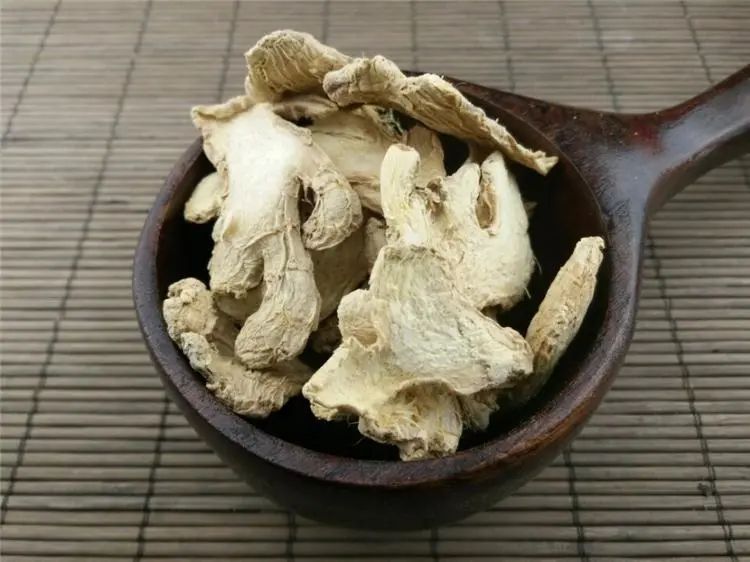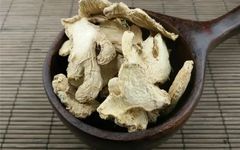Dried GingerGanjiangZINGIBERIS RHIZOMA
This product is the dried rhizome of the ginger plant, Zingiber officinale Rosc. Harvested in winter, the fibrous roots and soil are removed, and it is sun-dried or dried at low temperatures. Fresh slices that are dried are referred to as "dried ginger slices".
【Properties】Dried ginger appears as flat, block-like pieces with finger-like branches, measuring 3 to 7 cm in length and 1 to 2 cm in thickness. The surface is grayish-yellow or light gray-brown, rough, with longitudinal wrinkles and distinct nodes. Branching areas often retain scale leaves, and the tips of branches have stem scars or buds. The texture is solid, with a cross-section that is yellowish-white or grayish-white, powdery or granular, with distinct annular patterns in the inner skin layer and scattered yellow oil spots. It has a fragrant, distinctive aroma and a spicy taste.
Dried ginger slices are irregularly longitudinally or obliquely cut, with finger-like branches, measuring 1 to 6 cm in length, 1 to 2 cm in width, and 0.2 to 0.4 cm in thickness. The outer skin is grayish-yellow or light yellow-brown, rough, with longitudinal wrinkles and distinct nodes. The cut surface is grayish-yellow or grayish-white, slightly powdery, with many longitudinal fibers, some appearing hair-like. The texture is solid, with a fibrous cross-section. It has a fragrant, distinctive aroma and a spicy taste.
【Identification】(1) The powder of this product is light yellow-brown. Starch granules are numerous, oval, triangular, elliptical, round, or irregular in shape, with diameters ranging from 5 to 40 μm, with hilum points located at the smaller end, and some appearing fissured, with distinct layer markings. Oil cells and resin cells are scattered in the parenchyma, containing light yellow oil droplets or dark red-brown substances. Fibers are bundled or scattered, with blunt tips, few forks, and some sides appearing wavy or serrated, with diameters of 15 to 40 μm, with slightly thick walls, non-lignified, with oblique fine pores, and often with thin septa visible. Ladder-shaped vessels, spiral vessels, and reticulated vessels are common, with few annular vessels, with diameters of 15 to 70 μm. Tubular cells containing dark red-brown substances may sometimes be seen adjacent to vessels or fibers, with diameters of 12 to 20 μm.
(2) Take 1 g of this product's powder, add 20 ml of ethyl acetate, and treat with ultrasound for 10 minutes. Filter and take the filtrate as the test solution. Take 1 g of dried ginger as a control herb and prepare the control solution in the same manner. Then take a reference solution of 6-gingerol, prepared with ethyl acetate to contain 0.5 mg per 1 ml, as the reference solution. Perform thin-layer chromatography (TLC) tests (General Rule 0502), applying 6 μl of each of the three solutions onto the same silica gel G TLC plate, using petroleum ether (60-90°C)-chloroform-ethyl acetate (2:1:1) as the developing agent. Develop, remove, dry, and spray with vanillin-sulfuric acid reagent, heating at 105°C until the spots are clearly visible. In the test solution's chromatogram, spots of the same color as those in the control herb and reference solution should appear at corresponding positions.
【Examination】Moisture content must not exceed 19.0% (General Rule 0832, Method 4).
Total ash content must not exceed 6.0% (General Rule 2302).
【Extractable matter】Determined by the hot extraction method under the water-soluble extractive matter test (General Rule 2201), must not be less than 22.0%.
【Content determination】Volatile oil: Take an appropriate amount of the coarsely powdered product, add 700 ml of water, and determine according to the volatile oil determination method (General Rule 2204). The product must contain not less than 0.8% (ml/g) of volatile oil.
6-gingerol: Determined by high-performance liquid chromatography (HPLC) (General Rule 0512). The chromatographic conditions and system suitability test use octadecylsilyl-bonded silica as the stationary phase; acetonitrile-methanol-water (40:5:55) as the mobile phase; and a detection wavelength of 280 nm. The theoretical plate number for the 6-gingerol peak should not be less than 5000.
Preparation of the reference solution: Take an appropriate amount of 6-gingerol reference substance, accurately weigh, and dissolve in methanol to prepare a solution containing 0.1 mg per 1 ml.
Preparation of the test solution: Take about 0.25 g of the product powder (passed through a No. 3 sieve), accurately weigh, place in a stoppered conical flask, and accurately add 20 ml of 75% methanol. Weigh again, treat with ultrasound (power 100W, frequency 40 kHz) for 40 minutes, cool, weigh again, and use 75% methanol to make up for the weight lost, shake well, filter, and take the filtrate.
Determination method: Accurately take 10 μl of both the reference solution and the test solution, inject into the liquid chromatography system for measurement.
This product, calculated on a dry basis, must contain not less than 0.60% of 6-gingerol (C17H26O4).
Herbal slices
【Processing】Dried ginger: Remove impurities, soak briefly, wash clean, moisten thoroughly, cut into thick slices or blocks, and dry.
【Properties】This product appears as irregular slices or blocks, with a thickness of 0.2 to 0.4 cm.
【Identification】【Examination】【Extractable matter】【Content determination】 are the same as for the herb.
Ginger carbon: Take dried ginger blocks and fry according to the carbonization method (General Rule 0213) until the surface is black and the interior is brown.
【Properties】This product resembles dried ginger slices or blocks, with a blackened surface and brown interior, light in weight, and brittle in texture. It has a slightly bitter and mildly spicy taste.
【Identification】Take 2 g of this product's powder, add 40 ml of 75% methanol, treat with ultrasound for 20 minutes, filter, evaporate the filtrate to dryness, and dissolve the residue in 1 ml of ethyl acetate as the test solution. Take 6-gingerol reference substance and gingerol reference substance, and prepare each in ethyl acetate to contain 0.5 mg per 1 ml as reference solutions. Perform thin-layer chromatography (TLC) tests (General Rule 0502), applying 6 μl of the test solution and 6 μl of the 6-gingerol reference solution, and 4 μl of the gingerol reference solution onto the same silica gel G TLC plate, using petroleum ether (60-90°C)-chloroform-ethyl acetate (2:1:1) as the developing agent. Develop, remove, dry, and spray with vanillin-sulfuric acid reagent, heating at 105°C until the spots are clearly visible. In the test solution's chromatogram, spots of the same color as those in the reference solutions should appear at corresponding positions.
【Extractable matter】Same as for the herb, must not be less than 26.0%.
【Content determination】Same as for the herb, must contain not less than 0.050% of 6-gingerol (C₁₇H₂₆O₄).
【Flavor and Meridian Entry】Spicy, hot. Enters the Spleen, Stomach, Kidney, Heart, and Lung meridians.
【Functions and Indications】Warms the middle, disperses cold, revives yang, opens the meridians, warms the lungs, and transforms phlegm. Used for cold pain in the abdomen, vomiting, diarrhea, cold limbs with weak pulse, and cough with phlegm due to cold.
【Dosage】3 to 10 g.
【Storage】Store in a cool, dry place, protected from pests.
【Preparation】Ginger tincture.


